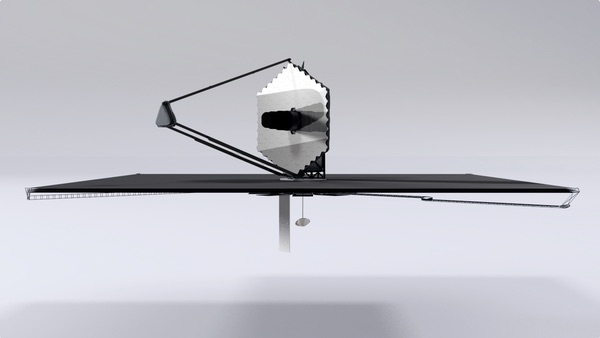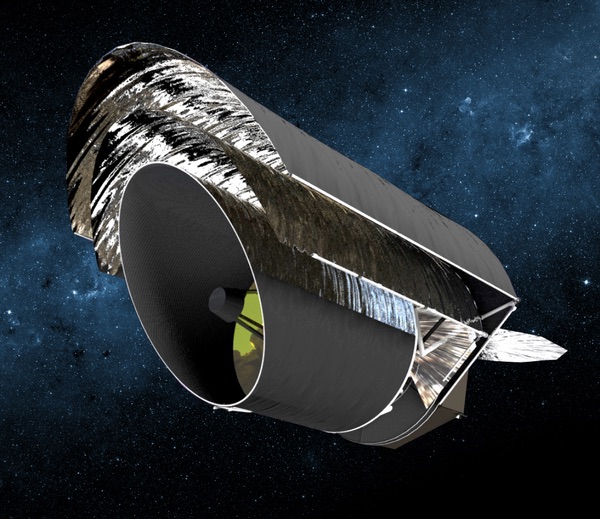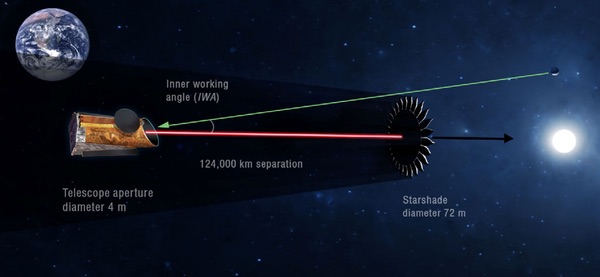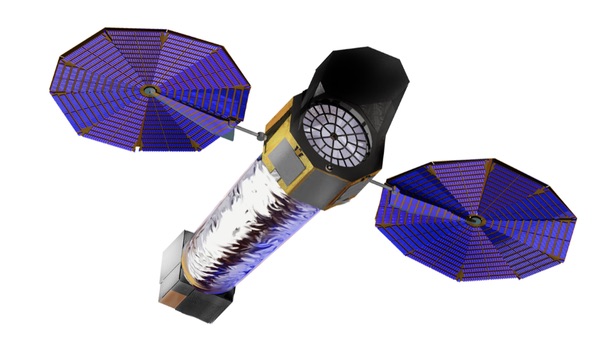Selecting the next great space observatoryby Jeff Foust
|
| “We’re trying to tell the story of life in the universe,” said O’Meara. “How do we read the book that the universe is trying to tell us?” |
From now until the release of its final report in late 2020, the committee and various supporting panels will evaluate the state of the field and identify scientific priorities for the next decade. It will then recommend the best ways to carry out those priorities, including support for theoretical research, groundbased telescopes, and smaller and mid-sized space missions, including “probe-class” spacecraft costing up to $1 billion each.
What will attract the most attention for Astro2020 is its analysis of proposed large space missions. Such spacecraft, called large strategic missions by NASA but often referred to as flagship missions, have the biggest potential to make groundbreaking discoveries in astrophysics, but carry with them the biggest price tags. Such missions have included, in the past, the Hubble Space Telescope, Chandra X-Ray Observatory, and the James Webb Space Telescope. The last decadal survey, in 2010, identified as its highest priority flagship mission the Wide-Field Infrared Survey Telescope (WFIRST).
Astro2020 won’t start with a blank slate in its consideration of flagship missions. NASA has supported studies for four proposed missions over the last few years, which will soon be completed and provided to the decadal survey committee. There’s no guarantee that the committee will select one of those missions, but given the effort put into the studies, from refining their scientific rationale to estimating their cost, it’s likely the mission the Astro2020 recommends as its highest priority flagship mission will at least look like one of the four.
The missions take widely varying approaches to addressing some common fundamental questions about the origin and evolution of the universe as well as the search for habitable worlds beyond our solar system.
 An illustration of the larger variant of LUVOIR, one of the large space telescope missions under consideration in the 2020 astrophysics decadal survey. (credit: NASA) |
One such mission is the Large Ultraviolet Optical Infrared Surveyor, or LUVOIR. One version of LUVOIR, called LUVOIR-A, would have a segmented primary mirror 15 meters across, the largest that could be assembled on the ground and launched on a single rocket, in this case the future Block 2 version of the Space Launch System (see “Repairing, and building, future space telescopes”, The Space Review, January 14, 2019). It would be by far the largest space telescope ever launched.
There is a smaller version of the mission, called LUVOIR-B, with a primary mirror eight meters across. “It basically maps out the parameter space of objects that could be launched in a single launch vehicle,” said John O’Meara of Keck Observatory, a member of the science and technology definition team (STDT) studying LUVOIR, during a January 8 session of the American Astronomical Society’s winter meeting in Seattle. “We did not consider architectures smaller than this because those architectures, at least for the LUVOIR team, would not still be LUVOIR.”
What that means is the science that astronomers hope a LUVOIR-like telescope could achieve. “We’re trying to tell the story of life in the universe,” he said, including the study of the formation and evolution of the universe, the formation of planetary systems, and the search for habitable or even inhabited exoplanets. “How do we read the book that the universe is trying to tell us?”
LUVOIR is billed as something of a general-purpose astrophysics observatory, capable of performing observations from the ultraviolet to the infrared with imaging and spectroscopic instruments. That will give the telescope the ability to do research from “cosmic origins” studies of the early universe to observations within our own solar system, the latter offering imaging capabilities rivaling that of spacecraft missions to those worlds. “I would be thrilled if I had a facility like LUVOIR to look at Enceladus month after month to do a long-term monitoring program to see how its plumes vary with time,” said Courtney Dressing of the University of California Berkeley, another STDT member, referring to the moon of Saturn with plumes of water ice.
Advocates of LUVOIR bill it as a next-generation Hubble, more so that JWST or WFIRST, which are more focused on infrared observations. “If you’re a Hubble user today, you really want to use LUVOIR,” said O’Meara.
 The “Concept-2” version of the Origins Space Telescope, a smaller version of the original design. (credit: NASA) |
Other proposed flagship missions are more specialized, but no less ambitious. The Origins Space Telescope, originally called the Far-Infrared Surveyor, originally a primary mirror 9.1 meters in diameter and a suite of instruments to perform observations at medium to far infrared wavelengths, from 5 to more than 600 microns. That’s designed to fill in a gap between JWST and groundbased submilllieter observatories like the Atacama Large Millimeter/submillimeter Array (ALMA) in Chile.
One key element of Origins is that its optics will be cooled to just four kelvins. “We can gain a 1,000 times improvement in sensitivity just by making the telescope cooled,” said Alexandra Pope of the University of Massachusetts Amherst during the same conference session.
That focus on the infrared will allow the telescope to address a wide range of scientific questions, from the formation of the first stars and galaxies to the search for biosignatures on exoplanets. “This telescope will be able to address a range of established, compelling science questions but also open a huge discovery space,” she said.
| “Lynx provides a factor from anywhere from 10 to 100 to 1,000 improvement,” said Özel. “A factor of 100 is almost like opening up a new wavelength.” |
The Origins team has since worked on an alternative, smaller concept with a primary mirror 5.9 meters across. Instead of looking like a scaled-up JWST, with a giant sunshield, it looks instead like a scaled-up version of the far smaller Spitzer Space Telescope. “It’s very simple. It has minimal deployments,” said Pope. The “Concept-2” version of the telescope retains the cooled optics of its larger version.
 How HabEx, working with a starshade, would directly image exoplanets. (credit: NASA) |
The Habitable Exoplanet Observatory, or HabEx, has a primary mission, as its name suggests, to search for habitable exoplanets. That includes taking images of them—something that would be enabled through the use of a separate starshade spacecraft to block light from the stars those exoplanets orbit—as well as collect spectra to look for biosignatures.
But proponents of HabEx don’t want the mission pigeonholed as only an exoplanet mission. “We were charged with maximizing the general astrophysics that could be achieved with this telescope,” Tyler Robinson of Northern Arizona University, a member of the HabEx STDT. “We worked exceptionally hard to keep general astrophysics on the same footing as exoplanet science.”
HabEx, like LUVOIR, will observe from the ultraviolet into the near infrared, although with a primary mission four meters in diameter, versus the eight- and 15-meter options for LUVOIR. Robinson said that the team is also looking at smaller, less expensive concepts for HabEx, with mirrors as small as 2.4 meters across, the same size as WFIRST. Also on the table, he said, is whether HabEx should have both a separate starshade as well as a coronagraph instrument, versus flying just one or the other.
The fourth flagship mission under study is Lynx, an x-ray observatory billed as a successor to Chandra. It’s considered something of a dark horse among astronomers, in part because the European Space Agency is working on its own major x-ray observatory mission, Athena, on which NASA will be a partner.
Advocates of Lynx, though, see it as a far better telescope than Athena in terms of parameters like field of view and sensitivity. “Lynx provides a factor from anywhere from 10 to 100 to 1,000 improvement” in those areas compared to Athena, said Feryal Özel of the University of Arizona, a chair of the Lynx STDT. “A factor of 100 is almost like opening up a new wavelength.”
Unlike the other missions, Lynx won’t do much in the area of exoplanet science, but it will “provide insight into the otherwise invisible universe,” she said. That includes studying supermassive black holes in the first galaxies, the processes that drive galaxy formation and evolution, and the high-energy aspects of stellar evolution.
All four study teams completed interim reports last year and are working on final reports in the next several months that will be delivered to NASA and from there to the Astro2020 committee. But one issue that will linger even after the final Astro2020 report with its mission recommendations is whether NASA, and Congress, will have the appetite to start work on another flagship mission any time in the foreseeable future.
Any reticence to do so is understandable. JWST, the top-priority flagship mission from the 2000 decadal survey, is years behind schedule and billions over budget, including problems announced last year that caused the telescope to break its $8 billion cost cap and delay its launch to the spring of 2021.
Last week, the House Appropriations Committee released a new package of fiscal year 2019 spending bills, based on negotiations with the Senate, in an effort to end the month-long partial government shutdown. The report accompanying the bill offered harsh words for JWST. “There is profound disappointment with both NASA and its contractors regarding mismanagement, complete lack of careful oversight, and overall poor basic workmanship on JWST,” the report stated. “NASA and its commercial partners seem to believe that congressional funding for this project and other development efforts is an entitlement, unaffected by failures to stay on schedule or within budget.”
The bill does give NASA the requested amount for JWST, a little more than $300 million, and increases the cost cap by $800 million to accommodate the latest overrun. But that came with a warning as well: “NASA should strictly adhere to this cap or, under this agreement, JWST will have to find cost savings or cancel the mission.”
WFIRST, the top flagship mission from the 2010 decadal survey, has also faced its budget problems, including an effort to get its cost below $3.2 billion. It had its own near-death experience last year when NASA’s 2019 budget proposal proposed cancelling the mission. Congress, though, rejected that call, and the latest House bill would give it $312 million for 2019, while warning it to remain within its cost cap.
| “NASA and its commercial partners seem to believe that congressional funding for this project and other development efforts is an entitlement, unaffected by failures to stay on schedule or within budget,” said a congressional report of JWST. |
NASA last year asked the study teams for the four proposed flagship missions to cut costs. In a June memo, Paul Hertz, director of NASA’s astrophysics division, told the HabEx, Lynx, and Origins team to aim for a cost of no more than $5 billion for their revised concepts. (LUVOIR was not given a specific cost cap, instead working on the LUVOIR-B concept that was the smallest version of the mission that could still achieve its science goals.)
“This is responsive to Decadal Survey best practices of providing a range of scientific scope for large mission concepts considered by Decadal Survey Committees,” Hertz wrote in his memo directing the smaller mission concepts. He added he wasn’t looking for “conservative” missions, per se. The goal, he wrote, “is to provide the Decadal Survey with a range of possibilities to inform their recommendations of a compelling astrophysics program for the next decade.”
The study teams, besides working on alternative concepts, have worked to get as far ahead on their designs as possible, identifying any key technologies or other issues as early as possible to avoid any problems down the road that would cause cost and schedule issues. Those studies are far more detailed than for earlier flagships, like JWST, at the same stage of consideration.
“Each one of these studies today has done far more than any mission concept study at this level of development in NASA’s history,” said O’Meara. “We are doing our homework, we are doing it well, and we’re doing it right.”
The Astro2020 committee will also be keeping costs in mind. Harrison, speaking at a town hall about the survey at the conference, said there will be “decision rules” about how to proceed “that accommodate a range of budgetary realities,” she said.
“We tend to be bullish” about the future, Kennicott, the other co-chair, said. “We want to be bold in our vision but, of course, we have to be realistic. We can’t recommend everything.”
Being bold won’t be a problem with the space telescope concepts under study. The realistic part will be trying to find a way for paying for whatever Astro2020 recommends, and seeing how long it takes for that concept to become reality.
Note: we are temporarily moderating all comments subcommitted to deal with a surge in spam.
